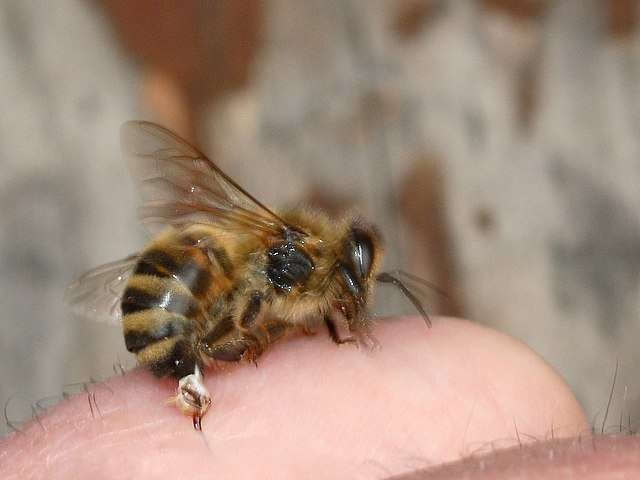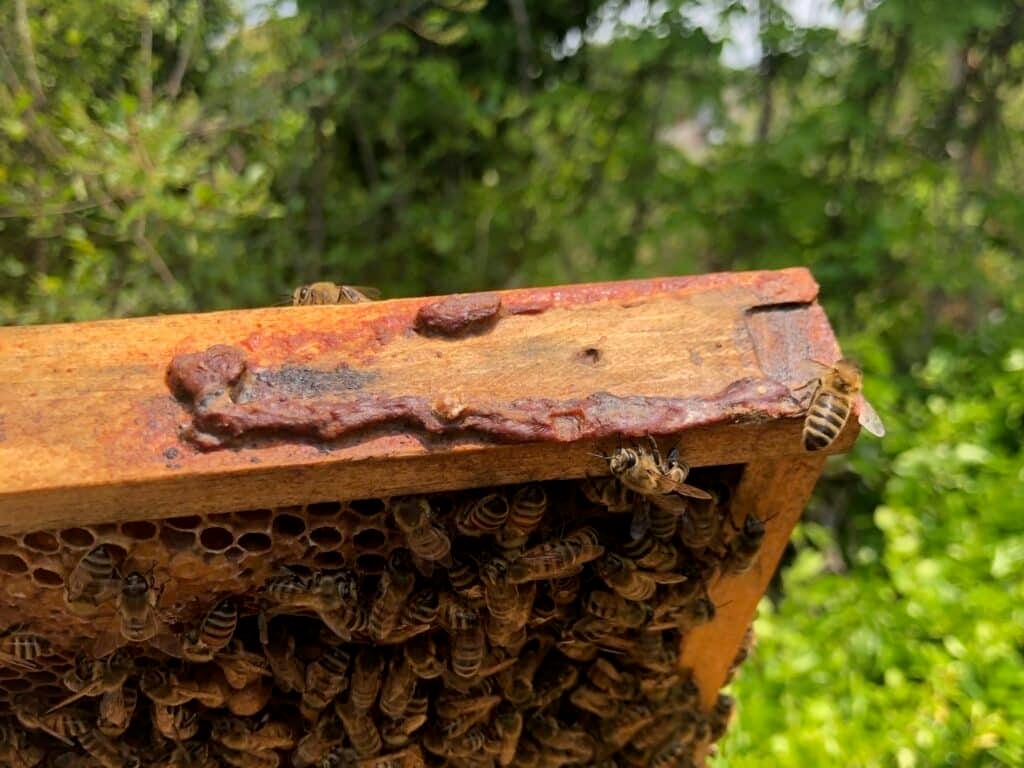Photo by Best Bees
Overview and Production
Bee venom (apitoxin) is a sophisticated biological weapon produced by honeybees (Apis mellifera) as their primary defense mechanism.
This colorless, odorless, and bitter-tasting liquid represents one of nature’s most complex toxins, containing over 50 identified bioactive compounds that work synergistically to protect bee colonies from threats.[1][2][3]
Anatomical Production System
Bee venom is produced by specialized venom glands located in the abdominal cavity of female worker bees and queens. The production system consists of three main components:[4]
- Venom glands: Two long, slender, convoluted tubules that synthesize and secrete the venom components[5]
- Venom reservoir: An ovoid storage sac where the completed venom accumulates[5]
- Sting apparatus: The delivery mechanism connected to the reservoir[5]
The venom glands undergo a single secretory cycle that begins at the end of pupation and reaches maximum production around day 16 of the worker bee’s adult life.
Each bee can produce approximately 0.15-0.3 mg of venom during its lifetime, with peak production occurring when bees transition into guard and forager roles.[6][5]
Chemical Composition
Bee venom is 88% water and contains a complex mixture of peptides, enzymes, amines, and other bioactive molecules. The major components include:[7]
Primary Active Compounds
Melittin – The dominant component, comprising 40-60% of dry venom weight. This 26-amino acid peptide is responsible for the intense pain associated with bee stings and exhibits powerful membrane-disrupting properties.[8][9][1]
Phospholipase A2 (PLA2) – Representing 12-15% of dry venom, this enzyme breaks down cell membranes and is the primary allergen responsible for severe allergic reactions.[10][1]
Apamin – A neurotoxic peptide comprising 2-3% of venom, which affects nerve tissue and contributes to the overall toxicity.[5]
Supporting Components
The venom also contains numerous enzymes including hyaluronidase (the “spreading factor”), acid phosphatase, and various biogenic amines such as histamine, dopamine, and norepinephrine. These work together to enhance venom penetration, cause inflammation, and amplify the pain response.[11][1]
How Bees Use Venom
Colony Defense Mechanism
Bees employ venom as part of a sophisticated multi-layered defense system designed to protect their colony from various threats. The defensive response involves:[12]
Guard bees – Specialized middle-aged workers (approximately 15% of the colony) stationed at the hive entrance who detect and respond to threats.[13][12]
Alarm pheromone release – When a bee stings, it simultaneously releases isopentyl acetate from the Koschevnikov gland, which smells like bananas and alerts other bees to the danger.[14][7]
Coordinated attack – The alarm pheromone triggers a cascade response, recruiting additional defenders to sting the intruder.[15][14]
Stinging Mechanism
The bee’s stinger is a highly evolved weapon consisting of barbed lancets that penetrate deep into vertebrate skin. Upon stinging:[7]
- The entire sting apparatus detaches from the bee, causing its death
- The venom sac continues pumping venom for several minutes after detachment[7]
- The barbed design ensures maximum venom delivery while preventing removal[7]
This kamikaze strategy represents an evolutionary adaptation where individual sacrifice maximizes colony protection.[16]
Non-Defensive Uses
Recent research has revealed that bees also use venom components for antimicrobial purposes within the hive. Additionally, queen bees use their venom specifically for fighting rival queens shortly after emergence, with queen venom being more potent against other bees than worker venom.[17][5]
Benefits for Bees
Evolutionary Advantages
Bee venom provides several critical survival benefits:
Effective deterrence – The intense pain and potential danger posed by bee stings create a powerful deterrent effect against predators, teaching them to avoid bee colonies.[18]
Colony preservation – By sacrificing individual bees, the colony’s genetic investment (stored in the queen and developing brood) is protected.[19]
Pathogen resistance – Venom components may serve as antimicrobial agents within the hive, helping maintain colony health.[17]
Social Immunity Function
The venom system operates as part of the colony’s social immunity, where individual immune responses contribute to overall colony health. This multi-level defense system helps protect against various threats including predatory insects, mammals, and potentially harmful microorganisms.[20]
Benefits for Humans
Traditional and Historical Uses
Bee venom therapy has been practiced for over 5,000 years across ancient civilizations including Egypt, Greece, and China. Hippocrates, known as the “Father of Medicine,” recognized bee venom’s therapeutic potential for treating arthritis and joint problems.[21][22]
Modern Therapeutic Applications
Contemporary research has identified numerous potential health benefits:
Anti-inflammatory effects – Melittin and other venom components demonstrate powerful anti-inflammatory properties that may benefit conditions like rheumatoid arthritis.[23][22]
Cancer research – Laboratory studies show that bee venom components, particularly melittin, can selectively target and destroy certain cancer cells while sparing healthy tissue.[24][25]
Neuroprotective properties – Research suggests potential applications in treating neurological conditions including Parkinson’s disease, multiple sclerosis, and Alzheimer’s disease.[22][26]
Antimicrobial activity – Bee venom exhibits broad-spectrum antimicrobial effects against bacteria, viruses, and fungi.[1][22]
FDA-Approved Applications
Currently, bee venom immunotherapy is FDA-approved for desensitizing individuals with severe bee sting allergies, providing 98-99% protection against future allergic reactions.[27]
Risks and Safety Considerations
Allergic Reactions
Bee venom poses significant risks for sensitive individuals:
Normal reactions include localized pain, swelling, and redness lasting several hours to days.[28][29]
Large local reactions involve swelling greater than 10cm in diameter persisting more than 24 hours.[10][28]
Anaphylaxis – The most serious complication, occurring in less than 1% of the population but potentially fatal without immediate treatment.[29][30]
Toxicity Concerns
Lethal dose – Approximately 2.8-3.5 mg per kg of body weight, requiring over 1,300 stings for an average adult.[2]
Delayed toxic reactions – Multiple stings (>50) can cause delayed organ failure, including kidney damage, liver dysfunction, and blood disorders.[31]
Therapeutic risks – Studies show that approximately 29% of patients receiving bee venom therapy experience adverse events, ranging from mild skin reactions to severe anaphylaxis.[32][33]
Clinical Considerations
Treatment Protocols
Medical bee venom therapy typically involves gradually increasing doses administered 2-3 times weekly under strict medical supervision. Practitioners must maintain emergency equipment including epinephrine injectors to manage potential anaphylactic reactions.[34][21]
Research Limitations
While promising, most therapeutic applications remain experimental and are not officially recognized by medical authorities in many countries. The American Cancer Society notes insufficient clinical evidence to support bee venom as a cancer treatment.[4][21]
Conclusion
Bee venom represents a remarkable example of evolutionary biochemistry, serving as both a sophisticated defense mechanism for honeybee colonies and a potential source of therapeutic compounds for human medicine.
Its complex composition of over 50 bioactive molecules demonstrates nature’s ability to create multi-functional biological tools.
For bees, venom provides essential colony protection through its deterrent effects and coordinated defense capabilities.
For humans, while bee venom offers promising therapeutic potential across numerous medical conditions, its use requires careful consideration of significant safety risks and should only be pursued under qualified medical supervision.
The ongoing research into bee venom’s mechanisms of action continues to reveal new potential applications while highlighting the importance of understanding both its beneficial and harmful effects.
As our knowledge expands, bee venom may become an increasingly valuable tool in modern medicine, bridging ancient wisdom with contemporary scientific understanding.
⁂
- https://pmc.ncbi.nlm.nih.gov/articles/PMC8400317/
- https://beeswiki.com/do-bees-have-venom/
- https://pmc.ncbi.nlm.nih.gov/articles/PMC10975291/
- https://en.wikipedia.org/wiki/Apitoxin
- https://beeculture.com/a-closer-look-venomvenom-glands/
- https://www.fao.org/4/w0076e/w0076e18.htm
- https://beeculture.com/bee-venom-chemistry-ouch/
- https://pmc.ncbi.nlm.nih.gov/articles/PMC5563768/
- https://en.wikipedia.org/wiki/Melittin
- https://pmc.ncbi.nlm.nih.gov/articles/PMC8395074/
- https://www.nature.com/articles/s41598-020-78740-1
- https://journals.biologists.com/jeb/article/219/22/3505/16667/The-defensive-response-of-the-honeybee-Apis
- https://pmc.ncbi.nlm.nih.gov/articles/PMC11923620/
- https://pmc.ncbi.nlm.nih.gov/articles/PMC6835895/
- https://beemission.com/blogs/news/bee-venom-part-2
- https://www.reddit.com/r/evolution/comments/vknej8/why_were_bee_stings_being_fatal_selected_for/
- https://www.sciencedirect.com/science/article/abs/pii/S004101011100273X
- https://us.manukahealth.com/nz/pages/learn-more-about-bee-venom
- https://www.chelseagreen.com/2023/honey-bee-venom/
- https://www.ars.usda.gov/ARSUserFiles/60500500/PDFFiles/501-600/560-Simone-Finstrom–Social immunity and superorganism.pdf
- https://chunginstitute.com/bee-venom-therapy/
- https://pmc.ncbi.nlm.nih.gov/articles/PMC11291246/
- https://www.powershealth.org/about-us/newsroom/health-library/2023/09/02/bee-venom-therapy-what-it-is-benefits-safety-side-effects-drug-interactions
- https://www.uclahealth.org/news/article/bee-venom-shows-promise-but-needs-more-study
- https://www.nature.com/articles/s41698-020-00129-0
- https://www.sciencedirect.com/science/article/abs/pii/S0143417924000507
- https://www.webmd.com/vitamins/ai/ingredientmono-972/bee-venom
- https://www.medicalnewstoday.com/articles/322075
- https://www.ars.usda.gov/pacific-west-area/tucson-az/carl-hayden-bee-research-center/docs/bee-safety/bee-stings-101/
- https://www.beeawareallergy.com/bee-stings/symptoms/an-inside-look-at-severe-reactions-to-bee-venom/
- https://pubmed.ncbi.nlm.nih.gov/9867899/
- https://pmc.ncbi.nlm.nih.gov/articles/PMC4440710/
- https://pmc.ncbi.nlm.nih.gov/articles/PMC9415809/
- https://beeculture.com/bee-venom-therapy/



